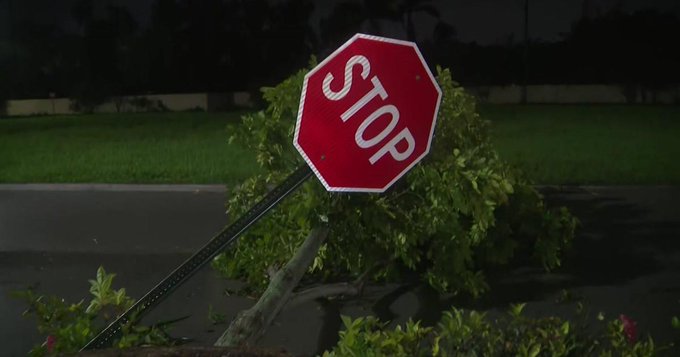
ST. PETERSBURG, Fla. (AP) — Hurricane Ian made landfall Wednesday in southwest Florida as one of the most powerful storms ever recorded in the U.S., swamping city streets with water and smashing trees along the coast.
The massive storm was expected to trigger flooding across a wide area of Florida as it crawls northeastward, and at least one sheriff’s office along the coast reported that it was already getting “a significant number of calls” from people trapped in their homes. The hurricane’s center struck near Cayo Costa, a protected barrier island just west of heavily populated Fort Myers.
Mark Pritchett stepped outside his home in Venice around the time the hurricane came ashore about 35 miles (56 kilometers) to the south. He called it “terrifying.”
The Category 4 storm slammed the coast with 150 mph (241 kph) winds and pushed a wall of storm surge accumulated during its slow march over the Gulf of Mexico. The storm previously tore into Cuba, killing two people and bringing down the country’s electrical grid.
About 2.5 million people were ordered to evacuate southwest Florida before the storm hit, but but by law no one could be forced to flee. Though expected to weaken as it marched inland at about 9 mph (14 kph), Ian’s hurricane force winds were likely to be felt well into central Florida.
“This is going to be a nasty nasty day, two days,” Florida Gov. Ron DeSantis said, stressing that people in Ian’s path along the coast should rush to the safest possible shelter and stay there.
Jackson Boone left his home near the coast and hunkered down at his law office in Venice with employees and their pets. Boone at one point opened a door to howling wind and rain flying sideways.
“We’re seeing tree damage, horizontal rain, very high wind — I think it’s a 100-plus sustained outside right now,” Boone said by telephone. “We have a 50-plus-year-old oak tree that has toppled over.”
In Naples, the first floor of a fire station was inundated with about 3 feet of water and firefighters worked to salvage gear from a firetruck stuck outside the garage in even deeper water, a video posted by the Naples Fire Department showed. Naples is in Collier County, where the sheriff’s department reported on Facebook that it was getting “a significant number of calls of people trapped by water in their homes” and that it would prioritize reaching people “reporting life threatening medical emergencies in deep water.”
Ian’s windspeed at landfall tied it for the fifth-strongest hurricane to strike the U.S., along with several other storms. Among them was Hurricane Charley, which hit almost the same spot on Florida’s coast in August 2004, killing 10 people and inflicting $14 billion in damage.
Ian had strengthened rapidly overnight, prompting Fort Myers handyman Tom Hawver to abandon his plan to weather the hurricane at home and head across the state to Fort Lauderdale.
“We were going to stay and then just decided when we got up, and they said 155 mph winds,” Hawver said. “We don’t have a generator. I just don’t see the advantage of sitting there in the dark, in a hot house, watching water come in your house.”
The governor said the state has 30,000 linemen, urban search and rescue teams, and 7,000 National Guard troops from Florida and elsewhere ready to help once the weather clears.
Florida residents rushed ahead of the impact to board up heir homes, stash precious belongings on upper floors and join long lines of cars leaving the shore.
Some decided to try and ride out the storm. Jared Lewis, a Tampa delivery driver, said his home has withstood hurricanes in the past, though not as powerful as Ian.
“It is kind of scary, makes you a bit anxious,” Lewis said. “After the last year of not having any, now you go to a Category 4 or 5. We are more used to the 2s and 3s.”
Ian made landfall more than 100 miles (160 kilometers) south of Tampa and St. Petersburg, sparing the densely populated Tampa Bay area from its first direct hit by a major hurricane since 1921. Officials warned residents that Tampa could still experience powerful winds and up to 20 inches (50 centimeters) of rain.
“Please, please, please be aware that we are not out of danger yet,” Tampa Mayor Jane Castor said in a video on Twitter. “Flooding is still going to occur.”
Flash floods were possible across all of Florida. Hazards include the polluted leftovers of Florida’s phosphate fertilizer mining industry, more than 1 billion tons of slightly radioactive waste contained in enormous ponds that could overflow in heavy rains.
Isolated tornadoes spun off the storm well ahead of landfall. One tornado damaged small planes and a hangar at the North Perry Airport, west of Hollywood along the Atlantic coast.
More than 1 million homes and businesses were without electricity, and Florida Power and Light warned those in Ian’s path to brace for days without power.
The federal government sent 300 ambulances with medical teams and was ready to truck in 3.7 million meals and 3.5 million liters of water once the storm passes.
“We’ll be there to help you clean up and rebuild, to help Florida get moving again,” President Joe Biden said Wednesday. “And we’ll be there every step of the way. That’s my absolute commitment to the people of the state of Florida.”
Parts of Georgia and South Carolina also could see flooding rains and some coastal surge into Saturday. Georgia Gov. Brian Kemp preemptively declared an emergency, ordering 500 National Guard troops onto standby.
Source: VosIzNeias